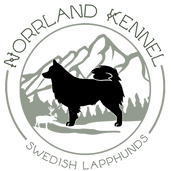
This is the standard as written for the FCI. To see the exact pdf file please clink on the link to the left.
You can also find more information on the standard here at SRSL's website (make sure to have google translate on for Swedish to English): https://www.srsl.se/rasinfo/rasstandards.html
At this time there is no standard written in AKC format.
Origin
Sweden
Utilization
Reindeer herding dog, nowadays mainly kept as an all-round companion dog.
Brief Historical Summary
The Swedish Lapphund has been known in the Nordic area for centuries. It is a Nordic Spitz used in the past for reindeer herding, hunting and as a watchdog by the nomadic Laplanders. Nowadays it is mainly kept as a versatile companion dog.
General Appearance
Typical Spitz dog of slightly less than medium size and with proud head carriage
Important Proportions
Rectangular body shape.
Behavior / Temperament
Lively, alert, kind and affectionate. The Lapphund is very receptive, attentive and willing to work. Its abilities as a good herding dog made it very useful in the reindeer trade. It is very versatile, suitable for obedience training, agility, herding, tracking, etc. It is easy to train, full of endurance and toughness.
Head
Cranial Region
Skull: Slightly longer than broad; forehead rounded and occiput not clearly defined.
Stop: Very well marked.
Facial Region
Nose: Preferably charcoal black, very dark or in harmony with coat colour.
Muzzle: A little more than one third of the length of the head. Foreface strong, evenly tapering evenly towards tip of nose. Nose bridge straight.
Lips: Close fitting. Palate and lips strongly pigmented.
Jaws/Teeth: Scissor bite with evenly set and well developed teeth
Eyes
Set well apart, almost horizontal, round, fairly big, but not protruding. Brown, preferably dark brown and full of expression. Rims strongly pigmented.
Ears
Triangular, broad at base, small, pricked, tips slightly rounded. Set well apart and very mobile. Tipped ears are undesirable but not a disqualifying fault.
Neck
Medium length, clean-cut and powerful.
Body
Well put together, slightly longer than height at withers.
Back: Level, strong, muscular and springy.
Loin: Short and broad.
Croup: Proportionally long and broad, slightly sloping and well muscled.
Chest: Rather deep reaching to elbow. Ribcage proportionally long and oval and with well-developed last ribs. Forechest well developed; well defined breastbone.
Underline and belly: Belly slightly tucked up
Tail
Rather high set, reaching to hock joint when extended. Carried curled over back when the dog is moving.
Limbs
Forequarters
General appearance: Forequarters should be sufficiently angulated at shoulders and elbows to provide good reach.
Shoulder: Shoulder blade well laid back.
Elbow: Fitting close to chest.
Forearm: Straight, strong and parallel, standing and moving.
Metacarpus (Pastern): Sufficiently slanting.
Forefeet: Strong, oval, with tightly knit toes, hardy and elastic padding; well covered with fur also between pads. Nails and pads strongly pigmented
Hindquarters
General appearance: Well angulated, but not exaggerated, in stifle and hock joint.
Thigh: Muscular.
Hock joint: Low-set to give power of propulsion.
Metatarsus (Rear pastern): Dewclaws permissible.
Hind feet: As forefeet
Gait / Movement
Light and springy, covering ground, parallel with drive.
Coat
Hair: Profuse double coat. Hair standing straight out from body, undercoat dense and finely frizzy. Short hair on head and on front of legs. Longer hair on brisket, backside of legs and on tail. Bushy, long and dense on tail. Forming a ruff round neck. The coat is weather resistant.
Colour: Usually solid black; bronzing is typical as more or less ”bear-brown” shades. White on chest, on feet and tip of tail is permissible.
Size and Weight
Height at the withers:
Ideal size for males: 48 cms. (18.9 inches)
Ideal size for females: 43 cms. (16.9 inches)
Allowance for +/- 3 cm. (1.2 inches)
Faults
Any departure from the foregoing points should be considered a fault and the seriousness with which the fault should be regarded should be in exact proportion to its degree and its effect upon the health and welfare of the dog.
Disqualifying Faults
• Aggressive or overly shy dogs.
• Any dog clearly showing physical or behavioral abnormalities.
• Untypical.
N.B.
• Male animals should have two apparently normal testicles fully descended into the scrotum
• Only functionally and clinically healthy dogs, with breed typical conformation should be used for breeding.